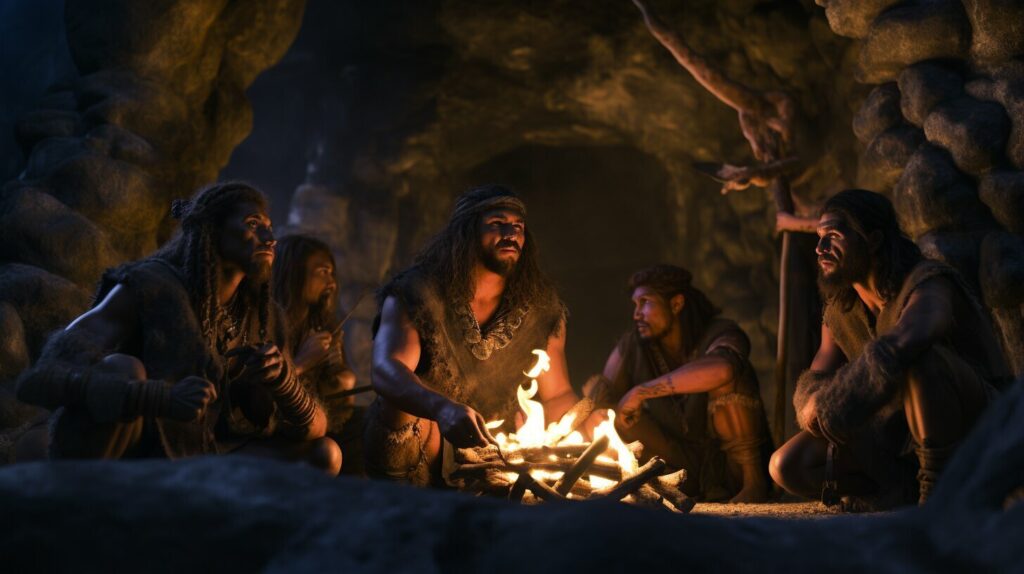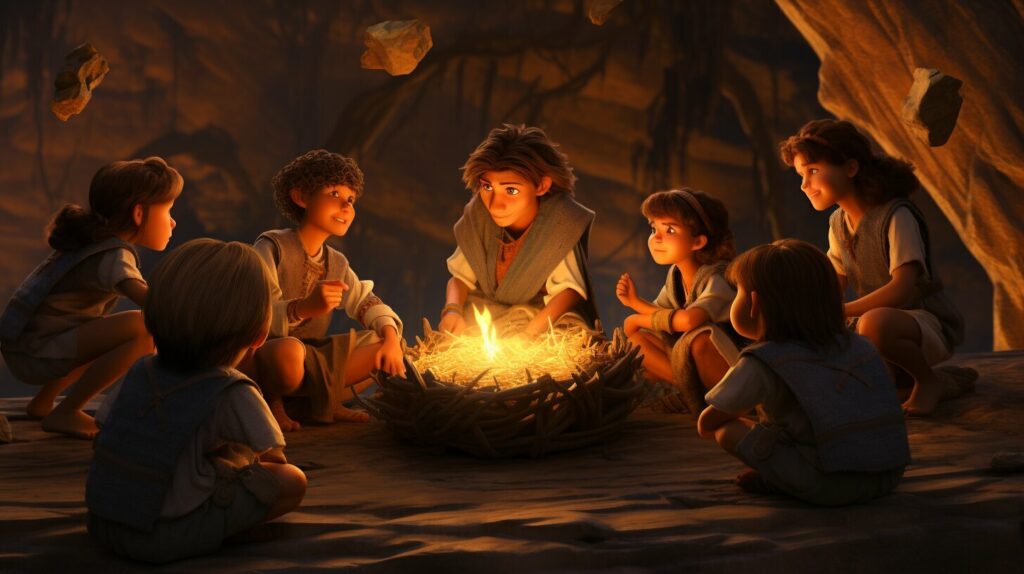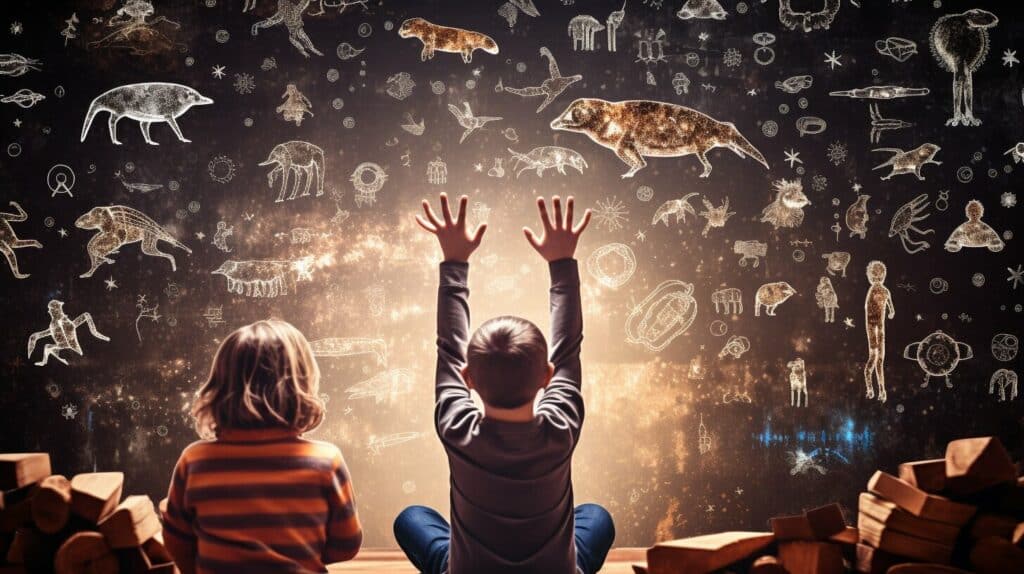As a parent, you want to provide your child with answers to their questions about the world around them. Explaining the concepts of Adam and Eve and cavemen can be a daunting task, but it’s an essential one to help your child understand the origins of humanity. In this guide, we will provide you with tips and strategies to effectively explain Adam, Eve, and cavemen to your child.
Key Takeaways
- Explaining Adam, Eve, and cavemen to your child requires age-appropriate information and storytelling techniques.
- It’s crucial to emphasize the similarities and differences between religious and scientific beliefs about human origins.
- Encouraging critical thinking and openness to different perspectives can help your child develop tolerance and understanding.
Understanding Adam and Eve
Adam and Eve is a popular biblical story that your child may have heard of either from you or in church. It’s essential to find a child-friendly way of explaining the story to them, it’s also important to emphasize key points and lessons.
Explaining the Story of Adam and Eve to Children
The story of Adam and Eve is about God creating the first human beings, Adam and Eve, who were put in a garden to live. God had given them one rule which was not to eat from the Tree of Knowledge of Good and Evil. However, Eve was tempted by a serpent to eat the fruit, and then Adam did so too. As a result, God punished them by casting them out of the garden, and they had to start a new life outside of it.
When explaining the story to your child, it’s important to emphasize the following:
- God’s love for all humanity
- The concept of temptation and making choices
- The importance of following rules
- The consequences of disobedience

Teaching Kids about Adam and Eve
It’s important to teach your kids about Adam and Eve in a simple and relatable way. A common way of doing this is by using storytelling or role-playing methods. Also, it’s important to consider your child’s age and maturity level when discussing the story.
It’s also important to explain to your children some of the cultural and ethical issues around Adam and Eve’s story, which include
- The origin of humanity
- The influence of temptation and the role it can play in our lives
- The concept of sin and punishment
- The importance of repentance and forgiveness
Discussing Adam and Eve with Kids
When discussing Adam and Eve with your child, be prepared to answer their questions. Some of the questions your child may ask are:
- Why did God create Adam and Eve?
- Why did Eve take the fruit?
- Why did Adam take the fruit?
- Why did God punish them?
- What happens next in the story?
It’s important to answer your child’s questions honestly and in a way that they understand. It’s okay if you don’t have all the answers, but you can always research and find them together with your child.
Explaining the story of Adam and Eve to your child can be a great opportunity to teach them about God’s love for all people, the importance of obedience, and the consequences of our actions.
With the right approach, it’s possible to instill valuable lessons about life from the story of Adam and Eve.
Introducing Cavemen and Early Humans
Now that your child has a basic understanding of the story of Adam and Eve, it’s time to introduce them to the concept of cavemen and early humans. Cavemen and early humans are often depicted in popular culture as wild, uncivilized creatures, but the truth is much more complicated.
Early humans, also known as hominins, were the first species of human to evolve. They lived over 6 million years ago and were quite different from modern humans. Their brains were much smaller, and they walked on two legs instead of four. The first hominin species, called Sahelanthropus tchadensis, lived in what is now Chad in Central Africa.
Over time, hominin species evolved and spread throughout Africa. They developed tools, learned to use fire, and eventually began to migrate out of Africa and into other parts of the world. Neanderthals, a type of early human, even lived alongside modern humans for a period of time.
Tools and Discoveries
One of the fascinating things about early humans is their ingenuity. Despite having limited resources, they were able to invent tools and come up with creative solutions to problems. For example, they used stones to create chopping tools and axes, and they used animal bones to create needles and awls for sewing.
In addition to tools, early humans also made important discoveries. They learned how to control fire, which allowed them to cook food and stay warm in cold weather. They also discovered agriculture, which allowed them to settle in one place and produce more food than they could gather.

Image Source: seowriting.ai
Finding Common Ground: Adam, Eve, and Cavemen
While the story of Adam and Eve is a religious tale, the existence of cavemen is backed by scientific evidence. It can be confusing for a child to understand how these two seemingly different concepts can coexist. However, by finding common ground, you can help your child make sense of it all.
The Importance of Stories
Both the story of Adam and Eve and the lives of cavemen are stories that have been passed down through generations. They both offer insights into human origins and provide explanations for the world we live in. While the Adam and Eve story is religious and the cavemen lifestyle is scientific, both serve the purpose of helping us understand our history.
The Role of Symbolism
Symbolism plays a crucial role in both the Adam and Eve story and the discovery of early humans. Adam and Eve represent the first humans, symbolic of the beginning of human life on Earth. The cavemen’s discovery sheds light on the beginnings of human civilization, symbolic of our journey as a species. Both offer lessons that can be learned through symbolism.
| Adam and Eve | Cavemen |
|---|---|
| Represent first humans | Discovered evidence of early humans |
| Symbolic of the beginning of human life | Symbolic of our journey as a species |
| Offers lessons learned through symbolism | Offers lessons learned through symbolism |
Exploring Differences and Similarities
It is important to explain to your child that while the Adam and Eve story and the cavemen discovery are different, they also have similarities. Both represent the journey of humanity and offer lessons to be learned. By exploring these differences and similarities, your child can begin to understand that while these concepts may seem different, they can coexist and be appreciated in their own way.

Addressing the Scientific Viewpoint
If your child is curious about how cavemen fit into the story of Adam and Eve, it may be helpful to explore the scientific viewpoint on human origins. While the Bible offers one explanation for the creation of humans, science provides another perspective based on empirical evidence.
The scientific viewpoint proposes that humans evolved from earlier hominid species over millions of years, through a process called natural selection. It suggests that early humans, or hominids, lived in Africa over 6 million years ago and gradually developed bipedalism, tool use, and other characteristics that distinguish them from modern apes.
Over time, different hominid species emerged, such as Homo habilis, Homo erectus, and eventually Homo sapiens, or modern humans. These species exhibited increasing brain size, social complexity, and technological advancement, leading to the diverse societies we see today.

It’s important to remember that these scientific explanations are not meant to disprove religious beliefs or discredit the story of Adam and Eve. Rather, they offer an additional perspective that can complement and enrich our understanding of human history.
How to Explain the Scientific Viewpoint to Your Child
Depending on your child’s age and level of interest, you can introduce the scientific viewpoint on human origins through books, videos, or interactive activities. Here are some tips:
- Choose age-appropriate resources that present the information in a clear and engaging way.
- Use simple language and avoid overwhelming your child with too much information at once.
- Encourage questions and curiosity, and be open to exploring different viewpoints together.
- Emphasize the importance of critical thinking and evaluating evidence, both in science and in other areas of life.
“Scientists have a lot of evidence that living things change over time. It’s like a puzzle that they try to solve by looking at fossils, bones, and other clues. They think that we humans evolved from earlier species, like monkeys and apes, over millions of years. Isn’t that fascinating?”
By providing your child with a well-rounded understanding of human history and different perspectives, you can help them develop critical thinking skills, empathy, and respect for diversity.
Emphasizing Symbolism and Beliefs
Now that your child has a basic understanding of Adam, Eve, and cavemen, it’s important to explore the symbolic elements of the Adam and Eve story. Encourage your child to think about the story as a metaphor for humanity’s journey through life. The story teaches us about the importance of free will, the consequences of our actions, and the power of temptation.
While different religions and belief systems may interpret the story differently, the essence of the message remains the same. Use this opportunity to discuss your own beliefs, as well as other beliefs and practices around the world. Explain that just because someone believes something different doesn’t mean they are wrong or bad.
“We are all human beings, and our beliefs and cultures make us unique and interesting. It’s important to respect and appreciate our differences.”
By emphasizing the symbolism and beliefs behind the Adam and Eve story, you can help your child develop a broader understanding of the world and the people in it.

Encouraging Critical Thinking
As you discuss Adam, Eve, and cavemen with your child, it’s important to encourage critical thinking and open-mindedness. Ask your child questions and encourage them to think beyond what they’ve been told or what they’ve read. For example, you might ask:
What do you think the story of Adam and Eve is trying to teach us?
Or:
Do you think it’s possible for the story of Adam and Eve and the existence of cavemen to both be true?
By asking these types of questions, you’re helping your child develop critical thinking skills and promoting a curious and questioning mindset.
It’s also important to remember that there may be different interpretations of the Adam and Eve story, and different beliefs about the origins of humans. Encourage your child to respect and appreciate different perspectives, even if they don’t agree with them.
Above all, foster a sense of wonder and curiosity in your child as they explore the story of Adam and Eve and the fascinating world of early humans.

Answering Questions and Clarifying Misconceptions
As you discuss Adam, Eve, and cavemen with your child, they may have questions and misconceptions that need to be addressed in order for them to fully understand the concepts. Here are some common questions and misconceptions you may encounter:
| Question/Misconception | Response/Clarification |
|---|---|
| Did cavemen and Adam and Eve live at the same time? | No, they did not. The story of Adam and Eve takes place in the Garden of Eden, while cavemen lived thousands of years later. |
| Did cavemen have rules and laws like we do today? | While they didn’t have structured laws like we do today, they did have social rules and norms that helped them function as a community. |
| Were Adam and Eve real people? | The story of Adam and Eve is a religious creation story that is open to interpretation. Some people believe it to be a literal event, while others view it as a symbolic representation of human origins. |
It’s important to provide factual information and correct any misconceptions your child may have. This will help them form a clearer understanding of the concepts and develop critical thinking skills. If you’re unsure about how to answer a question, don’t be afraid to do some research together or consult a trusted expert.

Remember, discussing Adam, Eve, and cavemen with your child is an ongoing conversation that requires patience and understanding. By addressing their questions and misconceptions, you can help them develop a deeper appreciation for the diversity of beliefs and perspectives in the world.
Encouraging Respect for Different Perspectives
As you discuss Adam, Eve, and cavemen with your child, it’s important to emphasize the significance of respecting different beliefs and viewpoints. This can help your child develop a sense of empathy and tolerance for others, which are valuable skills that will serve them well in life.
It’s okay if your child has different opinions or beliefs about Adam, Eve, and cavemen. Encourage them to ask questions and explore their curiosity about different ideas. Use this as an opportunity to teach them that diversity is a beautiful thing and that it’s important to embrace and celebrate differences, rather than judge and criticize them.
One way you can encourage respect for different perspectives is by exposing your child to stories and traditions from different cultures and religions. This can help them understand and appreciate the complexities of the world we live in and develop a broader perspective.
Remember that teaching your child about Adam, Eve, and cavemen is not about proving any particular viewpoint or belief system. Rather, it’s about fostering curiosity, critical thinking, and respect for different ideas and perspectives. By doing so, you can help your child develop into a well-rounded, open-minded individual who can contribute positively to society.

Conclusion
Congratulations! You now have the tools and knowledge to effectively explain Adam, Eve, and cavemen to your child. Remember to approach the topic with an open mind and an eagerness to learn alongside your child.
By understanding and respecting different beliefs and viewpoints, you can help your child develop a sense of tolerance and empathy towards others.
Don’t forget to encourage your child’s curiosity and critical thinking skills, answering their questions and clarifying any misconceptions along the way.
With these tips and guidance, you can confidently navigate the topic of Adam, Eve, and cavemen with your child, fostering a deeper understanding of our shared human history.
How Can I Explain the Differences Between Men and Women Using Adam, Eve, and Cavemen?
Adam, Eve, and cavemen are often used as symbols to understand the man and woman differences in child-rearing. While Adam and Eve depict the biblical perspective of gender roles, cavemen represent a primal stage where men and women had distinct responsibilities. These examples highlight fundamental dissimilarities in how each gender approaches parenting, which can help explain the man and woman differences in child upbringing throughout history and in today’s society.
FAQ
Q: How do I explain Adam, Eve, and cavemen to my child?
A: Explaining the story of Adam, Eve, and cavemen to your child can be a fun and educational experience. Here are some tips to help you:
Q: How can I teach my child about Adam and Eve?
A: Teaching your child about Adam and Eve can be done in a child-friendly manner. Here are a few suggestions:
Q: How do I introduce the concept of cavemen to my child?
A: Introducing the concept of cavemen to your child can be exciting and educational. Here’s how you can do it:
Q: How do Adam, Eve, and cavemen relate to each other?
A: While the stories of Adam, Eve, and cavemen may seem different, there are some connections. Here’s how you can explain it to your child:
Q: What is the scientific viewpoint on Adam, Eve, and cavemen?
A: Exploring the scientific viewpoint on human origins can complement the story of Adam and Eve. Here’s how you can approach it:
Q: Are there symbolic aspects to the story of Adam and Eve?
A: Yes, the story of Adam and Eve has symbolic meanings that can be discussed with your child. Here’s how you can approach it:
Q: How can I encourage critical thinking about Adam, Eve, and cavemen?
A: Encouraging critical thinking in your child about Adam, Eve, and cavemen is important. Here are some suggestions:
Q: What are common misconceptions about Adam, Eve, and cavemen?
A: There are some common misconceptions about Adam, Eve, and cavemen that you can address with your child. Here’s how:
Q: How can I teach my child to respect different perspectives regarding Adam, Eve, and cavemen?
A: Teaching your child to respect different beliefs and viewpoints is crucial. Here’s how you can encourage it:






